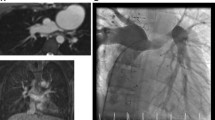Abstract
The aim of this study was to determine the histopathology of patent ductus arteriosus (PDA) in-stent stenosis after hybrid stage I palliation. The hybrid approach to palliation of hypoplastic left heart syndrome can be complicated by the development of in-stent stenosis of the PDA. This may obstruct retrograde aortic arch flow, decrease systemic circulation, and lead to interstage interventional procedures. Stented PDA samples removed from eight patients undergoing comprehensive stage II repair were examined by way of radiography and histochemistry (hematoxylin and eosin, Movat pentachrome, α-smooth muscle actin, and proliferating cell nuclear antigen). A retrospective chart review of the patients was also performed. PDA stents were in place in the PDA for a mean period of 169 ± 28 days in patients who had a mean age of 176 ± 30 days at the time of stent removal. Stent deployment caused chronic inflammation, caused fibrin deposition, and induced vascular smooth muscle–cell (VSMC) proliferation in the area immediately surrounding the stent struts. The neointimal region was composed largely of smooth muscle cells that appeared to be fully differentiated by the lack of PCNA staining. Neointimal thickening occurs in the PDA after stent placement for hybrid palliation of HLHS and is the result of inflammation, extracellular matrix deposition, and smooth muscle–cell proliferation in the peristrut region. This finding suggests that proliferating VSMCs in the peristrut region may provide the impetus for inward neointimal formation and therefore the manifestation of in-stent stenosis.


Similar content being viewed by others
References
Akaike T, Jin MH, Yokoyama U, Izumi-Nakaseko H, Jiao Q, Iwasaki S et al (2009) T-type Ca2+ channels promote oxygenation-induced closure of the rat ductus arteriosus not only by vasoconstriction but also by neointima formation. J Biol Chem 284:24025–24034
Alwi M, Choo KK, Latiff HA, Kandavello G, Samion H, Mulyadi MD (2004) Initial results and medium-term follow-up of stent implantation of patent ductus arteriosus in duct-dependent pulmonary circulation. J Am Coll Cardiol 44:438–445
Carter AJ, Laird JR, Farb A, Kufs W, Wortham DC, Virmani R (1994) Morphologic characteristics of lesion formation and time course of smooth muscle cell proliferation in a porcine proliferative restenosis model. J Am Coll Cardiol 24:1398–1405
Coe JY, Olley PM (1991) A novel method to maintain ductus arteriosus patency. J Am Coll Cardiol 18:837–841
Costa MA, Simon DI (2005) Molecular basis of restenosis and drug-eluting stents. Circulation 111:2257–2273
Galantowicz M, Cheatham JP (2005) Lessons learned from the development of a new hybrid strategy for the management of hypoplastic left heart syndrome. Pediatr Cardiol 26:190–199
Galantowicz M, Cheatham JP, Phillips A, Cua CL, Hoffman TM, Hill SL et al (2008) Hybrid approach for hypoplastic left heart syndrome: intermediate results after the learning curve. Ann Thorac Surg 85:2063–2070
Gibbs JL, Uzun O, Blackburn ME, Wren C, Hamilton JR, Watterson KG (1999) Fate of the stented arterial duct. Circulation 99:2621–2625
Hijazi ZM, Aronovitz MJ, Marx GR, Fulton DR (1993) Successful placement and re-expansion of a new balloon expandable stent to maintain patency of the ductus arteriosus in a newborn animal model. J Invasive Cardiol 5:351–357
Lee KJ, Hinek A, Chaturvedi RR, Almeida CL, Honjo O, Koren G et al (2009) Rapamycin-eluting stents in the arterial duct: experimental observations in the pig model. Circulation 119:2078–2085
Lowe HC, Schwartz RS, Mac Neill BD, Jang IK, Hayase M, Rogers C et al (2003) The porcine coronary model of in-stent restenosis: current status in the era of drug-eluting stents. Catheter Cardiovasc Interv 60:515–523
Nakatani M, Takeyama Y, Shibata M, Yorozuya M, Suzuki H, Koba S et al (2003) Mechanisms of restenosis after coronary intervention: difference between plain old balloon angioplasty and stenting. Cardiovasc Pathol 12:40–48
Rosenthal E, Qureshi SA, Tabatabaie AH, Persaud D, Kakadekar AP, Baker EJ et al (1996) Medium-term results of experimental stent implantation into the ductus arteriosus. Am Heart J 132:657–663
Schneider M, Zartner P, Sidiropoulos A, Konertz W, Hausdorf G (1998) Stent implantation of the arterial duct in newborns with duct-dependent circulation. Eur Heart J 19:1401–1409
Slomp J, Gittenberger-de Groot AC, Glukhova MA, Conny van Munsteren J, Kockx MM, Schwartz SM et al (1997) Differentiation, dedifferentiation, and apoptosis of smooth muscle cells during the development of the human ductus arteriosus. Arterioscler Thromb Vasc Biol 17:1003–1009
Stoica SC, Phillips AB, Egan M, Rodeman R, Chisolm J, Hill SL et al (2009) The retrograde aortic arch in the hybrid approach to hypoplastic left heart syndrome. Ann Thorac Surg 88:1939–1946
Virmani R, Farb A (1999) Pathology of in-stent restenosis. Curr Opin Lipidol 10:499–506
Acknowledgements
This work was supported in part by the National Institute of Health [LBI 2RO1HL5604-12 (PAL), 5T32HL098039 (AJT, PAL)] and The Heart Center at Nationwide Children’s Hospital. The authors also gratefully acknowledge the assistance of Naima Carter-Monroe, M.D. from CVPath Institute, Inc. in Gaithersburg, Maryland. The studies outlined in this manuscript were supported by The Center for Cardiovascular and Pulmonary Research and The Heart Center at Nationwide Children’s Hospital, Columbus, OH.
Author information
Authors and Affiliations
Corresponding author
Additional information
Matthew J. Egan and Aaron J. Trask contributed equally to this work.
Rights and permissions
About this article
Cite this article
Egan, M.J., Trask, A.J., Baker, P.B. et al. Histopathologic Evaluation of Patent Ductus Arteriosus Stents After Hybrid Stage I Palliation. Pediatr Cardiol 32, 413–417 (2011). https://doi.org/10.1007/s00246-010-9870-y
Received:
Accepted:
Published:
Issue Date:
DOI: https://doi.org/10.1007/s00246-010-9870-y




